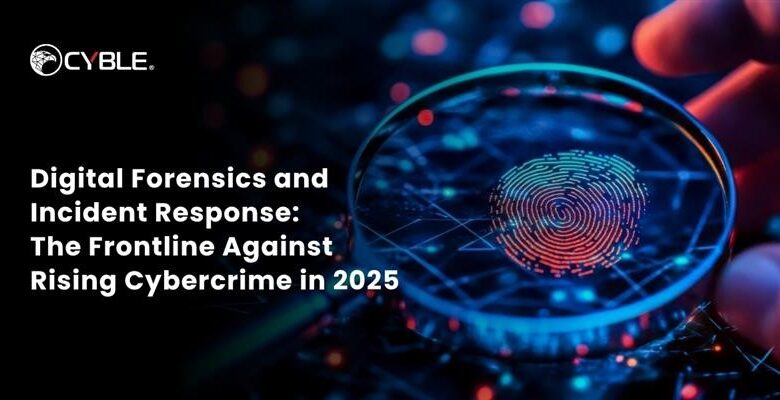Digital Forensics and Incident Response: The Frontline Against Rising Cybercrime in 2025

Cybercrime has become more sophisticated and complex than ever before, so the security of digital assets is a problem that almost every organization faces today. DFIR (Digital Forensics and Incident Response) is the first line of defense against these threats that keep getting bigger. This necessity of powerful DFIR solutions is something that the year 2025 will surely be witnessing. Technical and modern tools can be combined so that organizations will not only stay one step ahead of the villains but also protect their confidential information.
Digital Forensics and Incident Response is not merely about dealing with the attacks but rather it involves comprehending, preventing and lowering the effect of incidents to a degree that no major harm occurs. The cloud, AI, and devices overlapping in communication are the main reasons that digital crime is rising in speed, sophistication, and trade-offs in detection. Thus, in 2025, incident response for cybersecurity will be an indispensable part of every organization’s overall security strategy.
Why DFIR Is Important in 2025
In the past, sites of cyberattacks occurred rarely or in isolation and were followed by an incident response. Today, cybercriminals, and malicious insiders often attack continuously, adaptively, and sometimes even automatically. Digital Forensics/resolution is revolved to encompass more than traditional forensic practice; organizations will rely on Artificial Intelligence Digital Forensics resolution tools/systems in 2025 to quickly analyze large volumes of data, identify hidden threats and evidence, configurations, and develop patterns in order to prevent incidents in the future.
An example of this may be with a bank being attacked by ransomware. Traditional IT administration will restore and or backup affected systems, but if a warranted forensic investigation is not done, valuable evidence will not be collected in the process.
Digital forensic resolution/and response essentially adds the forensic rebuttable framework in 2025, meaning evidence is preserved throughout forensics/reinvestigation, and research can identify or establish the origination of attack or actor, make sense of/walk through the forensically recovered attack processes, as well as allow for organizations and responders to bolster successful defenses to the same kinds of attacks agents.
Incident Response Strategy 2025: Proactive and Agile
Effective cybersecurity incident response 2025 relies on preparation and agility. An incident response strategy 2025 should clearly define roles, responsibilities, and escalation procedures. Businesses must incorporate continuous threat monitoring, timely detection, and immediate containment measures. Organizations that embrace incident response best practices 2025 can significantly reduce the impact of cyberattacks, maintaining operational continuity and protecting their reputation.
Advanced forensic techniques 2025 play a critical role here. Techniques such as memory forensics, network traffic analysis, and endpoint detection allow DFIR teams to reconstruct attacks in detail. This capability not only identifies vulnerabilities but also provides actionable insights to prevent future breaches.
The Role of AI in Digital Forensics and Incident Response
In the year 2025, AI is a digital forensics revolution. The 2025 AI digital forensics facilitate swift examination of huge data sets, marking irregularities that may go undetected by humans. Thus, threat detection and reaction are sped up 2025, which causes organizations to become more robust against advanced attacks. Moreover, the AI-enabled analytics also help in incident prioritization, so the personnel will deal with the most critical threats first.
For instance, if a retail firm notices strange login activities through its cloud infrastructure, it can utilize AI digital forensics 2025 to find out the source and the way the intrusion was done. Companies that mix human skills and AI technologies are able to react quicker and in a more efficient manner.
Cyble, In the Digital Forensics and Incident Response area, they develop solutions aimed at helping organizations cope with and recover from cyber attacks in a quick and efficient manner. Their DFIR solutions 2025 consolidate the processes of threat detection, evidence collection, and response strategies being proactive. Cyble can assure organizations will have the capability for early breach detection, prompt response, and little to no impact on operations, by using a mix of AI, advanced analytics, and professionals with extensive experience.
The services provided by Cyble are not confined to defensive actions. They offer continuous support for cybersecurity incident response 2025, assisting organizations in establishing solid policies, training their personnel, and staying ready to confront the threats of cybercrime that are constantly changing. This all-encompassing method is in line with the best practices of incident response and digital forensics in 2025.
Conclusion
Digital Forensics and Incident Response is more than just a technical execution to demonstrate admissible evidence that could have assisted in responding to a breach event and to appease regulatory bodies. It is a cultural consideration for organizations to maintain an understanding of the cyber threat landscape, evidence preservation, and response to an incident. As such, the organization’s understanding of potential threats, preservation of evidence, and incident response best practices must extend in 2025 to the various levels in which an organization operates.
When organizations employ DFIR into their overall cyber defense strategy development, they are developing cyber resilience, while mitigating downtime, and preserving customer trust that they can respond to a cyber-attack. In 2025, the responsibility for the cybercrime investigative activity is more than just an IT team function.
Legal, compliance and management must work together to fulfill proper documentation standards while remaining compliant to regulations, and coordinating communication. These approaches collectively strengthen an organization’s overall defenses and response to threats.



